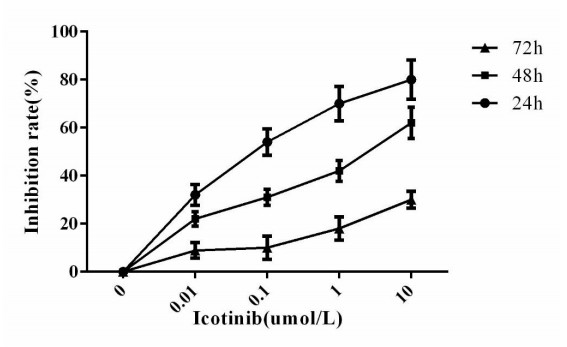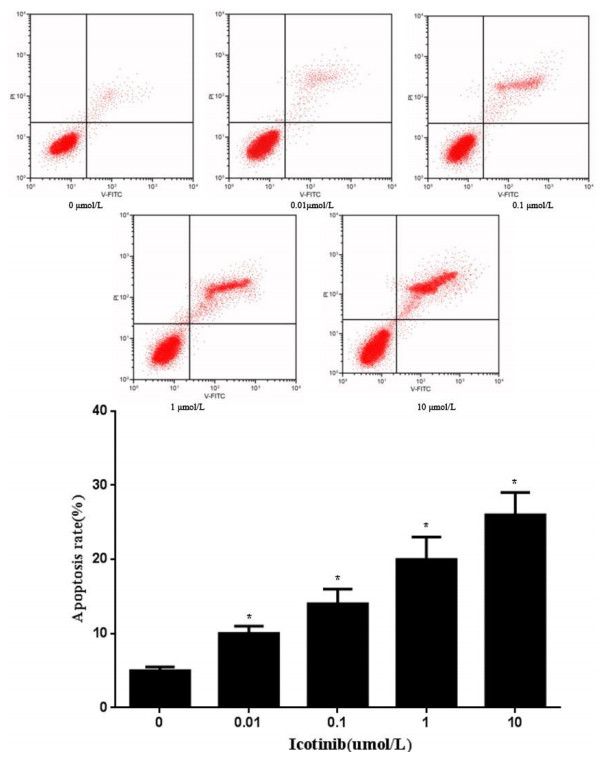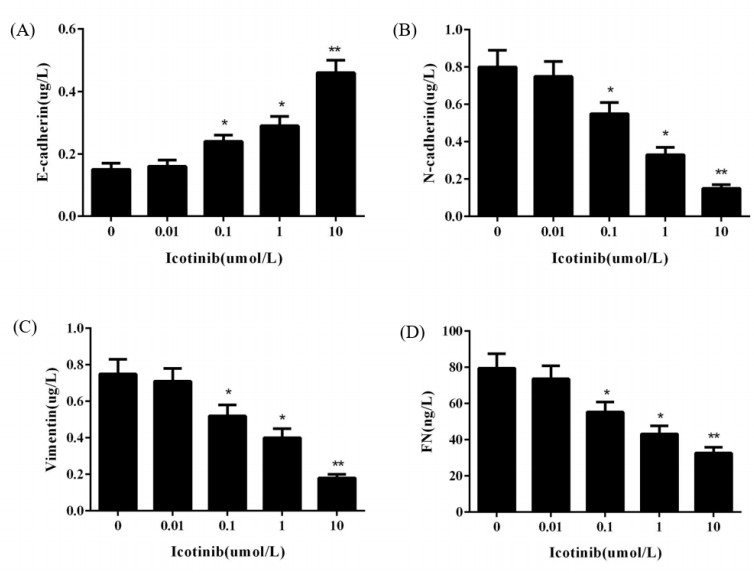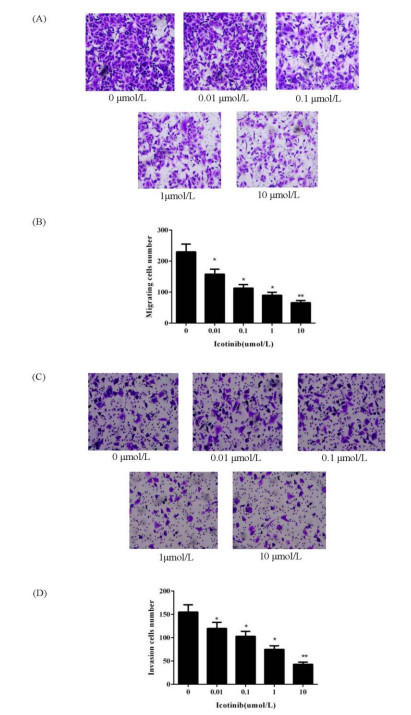ObjectiveTo investigate the inhibitory effect of Icotinib on proliferation and epithelial-mesenchymal transition of A549 cells.
MethodsA549 cells were treated with Icotinib of different concentrations. The morphology of the cells was observed by inverted phase contrast microscope. The effect of different concentrations of Icotinib on the proliferation inhibition rate of A549 cells was detected by MTT assay. Flow cytometry was used to detect effect of Icotinib on the apoptosis rate of A549 cells. ELISA assay was used to detect the expression of EMT-related proteins, E-cadherin, N-cadherin, Vimentin and fibronectin, in A549 cells cultured supernatant. Transwell assay was used to examine the effects of different concentrations of Icotinib on the migration and invasion abilities of A549 cells.
ResultsMorphological changes were observed after A549 cells exposed to different concentrations of Icotinib for 48 hours. The inhibition rate of proliferation for each treatment group increased from MTT assay results. Flow cytometry results showed that cell apoptosis rate was significantly increased. Expression of E-cadherin was up-regulated and expression of N-cadherin, Vimentin and fibronectin were down-regulated from ELISA results. A549 cell migration and invasion abilities were significantly suppressed by Icotinib at different concentrations.
ConclusionIcotinib inhibits A549 cell proliferation, migration and invasion in both concentration and time-dependent manners, in turn it promotes A549 cell apoptosis in the same way. Icotinib also inhibits epithelial-mesenchymal transition by regulating EMT-related proteins expression in A549 cells.
1.
Introduction
Lung cancer is one of the leading causes of death among all types of cancer worldwide. About 80–85% of lung cancers are non-small cell lung cancer (NSCLC), and more than half of NSCLC patients are diagnosed with cancer in advanced stage [1]. Although there are various of treatments for NSCLC, the effect of treatments is poor without effective prognostic approaches [2]. Currently, chemotherapy for NSCLC patients has still remained in the advanced stage [3,4]. Therefore, new methods are needed to be found for treating NSCLC. With further researches on the pathogenesis of cancer, many target genes related to the pathogenesis of NSCLC have been discovered and researches on these genes will help us to find new therapies.
Epidermal growth factor receptor (EGFR) is one of the most promising molecular targets in researches on NSCLC targets. In the study of NSCLC patients, Santarpia et al. found that EGFR protein expression could be detected in tissue samples of more than 50% of NSCLC patients [5]. Thongprasert et al. found that overexpression or mutation of EGFR would inhibit the proliferation of tumor tissues including that of NSCLC [6]. Currently, drugs targeting EGFR are widely used in clinical practice and these drugs have a great effect on prolonging survival time of patients.
Icotinib, a new type small-molecular tyrosine kinase inhibitor targeting EGFR (EGFR-TKI), is independently designed by researchers from China, which is also concerned by many researchers [7,8,9]. Mu et al. found that Icotinib could significantly inhibit the proliferation of EGFR-mutated HCC827 lung cancer cells and they also found that Icotinib could inhibit the phosphorylation of EGFR, Akt and extracellular signal-regulated kinase (ERK) [10]. In present study, we detected the cell growth activity of lung cancer A549 cell line treated with different concentrations of Icotinib to explore the inhibitory effect of Icotinib on the proliferation and epithelial-mesenchymal transition (EMT) of NSCLC cells [11,12,13,14,15].
2.
Materials and method
2.1. Cell line and reagents
A549 cells, a kind of human NSCLC cell line, were obtained from the Type Culture Collection of Chinese Academy of Sciences (Shanghai, China). RPMI 1640 medium was purchased from Sigma Co. (St. Louis, MO, USA). Icotinib was purchased from Betta Pharmaceuticals Co., Ltd (Zhejiang, China), and dissolved in 5% DMSO and stored at -20 ℃ without light. MTT, DMSO and trypsin were all from Sigma Co. (St. Louis, MO, USA). Inverted microscope was purchased from OLYMPUS (Tokyo, Japan). Accuri C6 flow cytometry, CellQuest software and ELISA kit were all obtained from BD (New Jersey, USA). Enzyme-labeled instrument was from Bio-Rad (Hercules, CA, USA).
2.2. Cell culture and groups
A549 cells were maintained in RPMI 1640 medium with 10% fetal bovine serum containing 100U/ml penicillin and 100μg/mL streptomycin and cultured in an incubator (5% CO2, 37℃). Cells grown to 70 to 80% confluence were digested with 0.25% trypsin and cells at logarithmic growth phase were applied to perform experiments. Quiescent A549 cells were seeded into a 6-well culture plate and treated with Icotinib at indicated concentrations (0, 0.01, 0.1, 1, 10 μmol/L). After 48 hours, A549 cells growth status and morphological changes were observed under inverted microscope. The equation of cell conform factor: CF = C2 / (4pS). C is perimeter of cells. S is cell surface area. P = 0.314. The results of C and S were measured by Image J. The high value of CF represents the low roundness of cells.
2.3. Proliferation assay
3-(4, 5-Dimethylthiazol-2-Yl)-2, 5-Diphenyltetrazolium Bromide (MTT) was applied to determine A549 cell proliferation. A549 cells were seeded into a 96-well culture plate at a density of 1 × 104 cells/well and allowed to grow to subconfluence. A549 cells were serum-deprived for 24 hours before cells were treated with Icotinib at indicated concentrations for 24 hours, 48 hours and 72 hours. MTT incubation and absorbance were performed according to the manufacturer's instruction. Each count was an average of three repetitions.
2.4. Cell migration
A549 cell migration was measured by Transwell assay. Cells were seeded onto the upper chamber of 24-well culture plate at a density of 2 × 105 cells/well, and 500 μl RPMI 1640 medium was added into the lower chamber. Cells were free grown for 24 hours in an incubator and then moved away from the upper chamber and cells in lower chamber were fixed with 4% paraformaldehyde for 30 min. Cells were stained with 0.1% crystal violet and counted under a phase-contrast microscope. At least 6 scopes were chosen in each group under microscope and all experiments were repeated at least 3 times. A549 cell invasion ability was detected by transwell invasion assay and all operations were the same as proliferation assay except adding Matrigel matrix onto the upper chamber.
2.5. Flow cytometry
A549 cell apoptosis was assessed by flow cytometry. A549 cells were seeded onto a 6-well culture plate at a density of 3×105 cells/well and treated with Icotinib at indicated concentrations. After 48 hours incubation, cells were resuspended with 100 μl 1 × Binding Buffer and stained with 5μl Annexin V-FITC solution for 10 min in the darkness at room temperature. Then cells were also incubated with 5μl propidium iodide solution for 5min in the darkness and 500μl PBS was added for detection of apoptosis by Accuri C6 flow cytometry. Data were analyzed by using Cell-Quest software (BD Bioscience). All experiments were repeated at least 3 times.
2.6. ELISA analysis
Cells were treated with Icotinib at indicated concentrations for 48 hours and cultured supernatant was collected for detection of EMT related proteins (E-cadherin, N-cadherin, Vimentin and fibronectin) by using ELISA kit. All procedures were strictly performed according to the manufacturer's instruction of ELISA kit. All experiments were repeated at least 3 times.
2.7. Statistical analysis
All data were performed and analyzed with the 21.0 SPSS statistical software. Measurement data were expressed as mean ± standard error of mean (SEM). Comparison between two groups was made by t test, and comparison among groups was made by Repeated Measures ANOVA. P value of less than 0.05 was regarded to have statistical significance. Error bars on all graphs were presented as the SEM unless otherwise indicated.
3.
Results
3.1. Effect of Icotinib on A549 cells morphological changes
A549 cells morphological changes were observed by using an inverted microscope after treatment with Icotinib for 48 hours. Results showed that Icotinib could influence cell morphology of A549 cells from low concentration to high concentration. In the group of 0.01 μmol/L Icotinib, A549 cells had a tendency from fusiform type to globular type compared with control group (only with the same volume of DMSO), and this tendency was more obvious in group of 0.1 μmol/L Icotinib. When the Icotinib concentration reached to 1μmol/L, A549 cells became shrink and even occurred granule denaturation. We also found granule agammaegation and apoptosis body emerged in A549 cells at 10umol/L of Icotinib (Figure 1A). The results of CF showed that the cell conform factor of cells treated with 0.01 and 0.1 umol/L Icotinib were lower than that of cells with no treatment (Figure 1B). However, the cell conforms factor of cells that treated with 1 and 10umol/L Icotinib was higher than cells that had no treatment.
3.2. Icotinib inhibited the proliferation of A549 cells
Effect of Icotinib on the proliferation of A549 cells was determined by MTT assay. Consistent with others studies [16,17], we also demonstrated that Icotinib inhibited A549 cell proliferation in both concentration and time-dependent manners (Figure 2). Furthermore, results also revealed that after 72 hours, Icotinib at the concentration of 10μmol/L had the strongest inhibitory effect on proliferation of A549 cells (P < 0.05) (Figure 2). These results indicated that Icotinib had a fierce inhibitory effect on A549 cell proliferation.
3.3. Icotinib accelerated A549 cell apoptosis
A549 cells were treated with Icotinib at indicated concentrations for 48 hours and cell apoptosis rate was detected by flow cytometry. Results revealed that rate of A549 cell apoptosis in Icotinib group was higher than that of control group, furthermore, the rate of apoptosis was gradually elevated along with the concentration of Icotinib from 0.01μmol/L to 10 μmol/L (Figure 3A). These differences compared with control group were statistically significant (P < 0.05) (Figure 3B).
3.4. Icotinib mediated the course of EMT in A549 cells via regulating expression of EMT-related proteins
Epithelial mesenchymal transition (EMT) is considered as a pivotal element for the onset of a variety of carcinomas [18,19,20]. Keep this view in mind, we hypothesized that Icotinib could mediate the EMT program in A549 cells. To manifest our hypothesis, we detected expression of EMT-related proteins, such as E-cadherin, N-cadherin, Vimentin and fibronectin in A549 cells cultured supernatant by using ELISA kit. As shown in the results, we found that expression of the epithelial marker, E-cadherin, drastically elevated compared with control group when A549 cells were treated with Icotinib at the concentration of 0.1μmol/L, 1μmol/L and 10μmol/L (P < 0.05) (Figure 4A), meanwhile, expression of N-cadherin, Vimentin and FN evidently decreased in indicated groups compared with control group (P < 0.05) (Figure 4B, C and D). Particularly, when the concentration of Icotinib was 10μmol/L, all these proteins expression changed more obviously (P < 0.01). These data validated our hypothesis that Icotinib inhibited EMT program in A549 cells through mediating expression of EMT-related proteins and fibronectins.
3.5. Effect of Icotinib on migration and invasion ability of A549 cells
We performed transwell assay to confirm whether Icotinib could regulate the ability of migration and invasion of A549 cells. As illustrated in Figure 5A and B, Icotinib at the concentration of 0.01, 0.1 and 1 μmol/L distinctly restrained the migration of A549 cells compared with control group (P < 0.05). Consistent with migration results, Icotinib at indicated concentrations could also suppress invasion ability of A549 cells (P < 0.05) (Figure 5C and D), moreover, this inhibitory effect of Icotinib at the concentration of 10μmol/L on A549 cells was stronger than other groups (P < 0.01). Taken together, these data suggested that Icotinib could inhibit the migration and invasion ability of A549 cells.
4.
Discussion
Targeted chemotherapy in epidermal growth factor receptor (EGFR)–mutant non–small cell lung cancer is a prevalent strategy for the treatment of NSCLC [11,21]. Icotinib is a potent and reversible EGFR- small-molecule tyrosine kinase inhibitor, which has been approved by the State Food and Drug Administration of China and shown an excellent clinical efficacy in advanced NSCLC treatment [15,17,22,23]. In line with excellent clinical efficacy, it has been reported that EGFR mutation accounted for 71.1% of advanced NSCLC patients, of which the deletion of exon 19 accounted for approximately 32%; The ORR and DCR of patients with EGFR mutation after treatment with Icotinib were 54.1% and 93.5%, respectively [24].
In our study, we explored the anti-tumor effect of Icotinib at different concentrations on one type of NSCLC cell line. All these data indicated that Icotinib significantly suppressed the proliferation and accelerated the apoptosis of A549 cells. In addition, we also confirmed that Icotinib can restrain the EMT program through mediating expression of EMT-related markers of A549 cells. When the EMT program disturbed by Icotinib, we automatically detected and found that the migration and invasion ability of A549 cells were obviously depressed. Moreover, consistent with previous studies [25,26,27], Icotinib inhibited A549 cell proliferation and EMT program in both concentration and time-dependent manners.
5.
Conclusion
In conclusion, molecular targeted therapy is a novel manner for the treatment of lung cancer, however, acquired-drug resistance is an inevitable limitation for molecular targeted therapy. Various mechanisms are involved in tumor pathogenesis and drug resistance; therefore, we must have a well understanding on the molecular mechanism of TKI acquired-drug resistance in order to make an optimal and effective treatment strategy for NSCLC patients. All in all, a number of basic researches and clinical trials are needed to do for the treatment of NSCLC.
Conflict of interest
The authors declare that they have no conflict of interest.
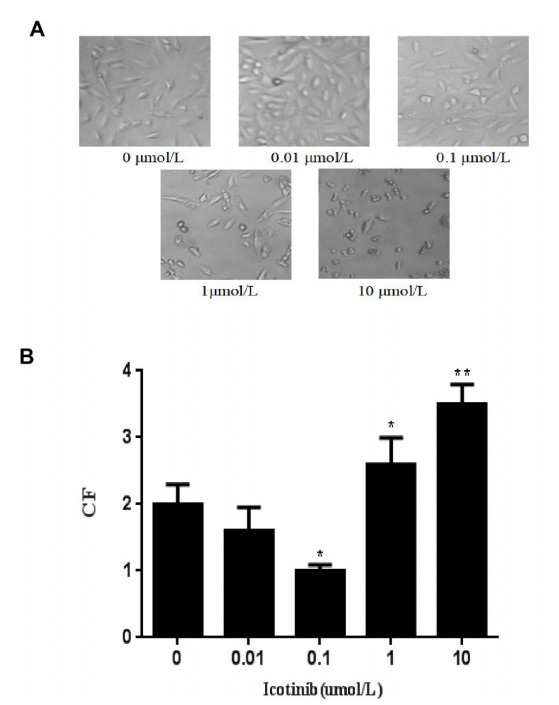









 DownLoad:
DownLoad:






